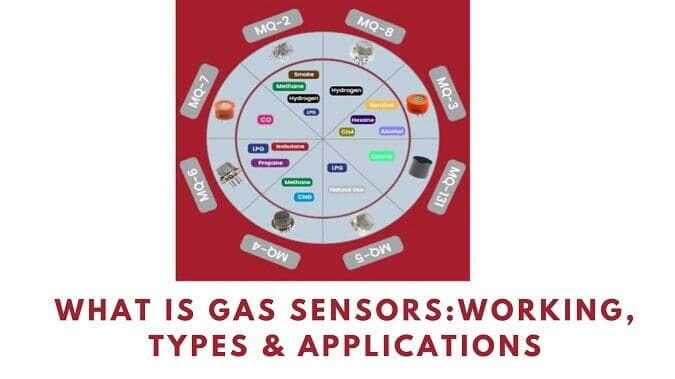
A gas sensor is basically electronic sensor device that can find out if some gases are around and how much of them there are in the air. It turns the chemical reactions between the gas it’s looking for and a special material into an electrical signal. You usually see these sensors used to keep an eye on air quality, find dangerous gases, and help keep things safe in places like mines, factories, and hospitals.
Gas detector sensors are really important because they give exact, real-time information about gas levels, helping to keep both the environment and worker safety in check. There are different kinds like electrochemical, infrared, and semiconductor sensors, and each one is made for spotting particular gases.
Working of Gas Sensor
A gas sensor is an instrument designed to detect and quantify the concentration of specific gases present in the atmosphere. Although the operational mechanisms may vary depending on the type of sensor employed, they all adhere to a foundational principle comprised of the following components:
1. Sensing Element
This is the primary component of the sensor, which interacts with the target gas. Upon contact with the sensing material, a change occurs, which may be either physical or chemical in nature.
2. Conversion to Electrical Signal
This change, such as a variation in electrical resistance, current, or voltage, is captured and converted into an electrical signal. The magnitude of this signal correlates with the concentration of the gas.
3. Signal Processing
Subsequently, the circuitry of the sensor processes and calibrates the electrical signal to yield a meaningful output, such as the gas concentration measured in parts per million (ppm).
4. Output
The final signal is then displayed on a monitoring device or transmitted to a control system, which may initiate an alarm or activate ventilation systems as necessary.
The operational methodology of the sensor may differ based on the specific detection technique employed, such as electrochemical reactions, infrared absorption, or variations in thermal conductivity.
Types of Gas Sensor
Gas sensors are essential components in various industries to monitor gas concentrations for safety, environmental protection, and process optimization. These sensors come in different types, each suited for specific applications based on their detection mechanisms and the gases they are designed to sense. Here’s a detailed look at the major types of gas sensors and their working principles, as well as their applications across sectors:
1. Semiconductor Gas Sensors (Metal Oxide Sensors)
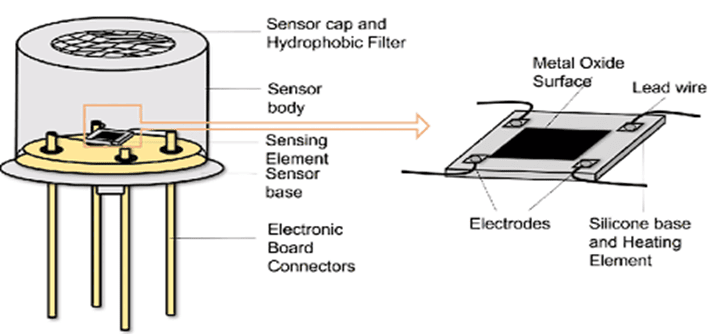
Working Principle of Semiconductor Gas Sensors
Semiconductor gas detection sensors, often based on metal oxide materials (such as tin oxide or zinc oxide), detect gases by measuring changes in electrical resistance. When gases come into contact with the sensor, they either donate or accept electrons from the semiconductor material, altering its conductivity. The sensor typically operates at elevated temperatures, enhancing its sensitivity.
- Common Gases Detected:
- Carbon Monoxide (CO)
- Nitrogen Oxides (NOx)
- Methane (CH₄)
- Ammonia (NH₃)
- Volatile Organic Compounds (VOCs)
- Applications:
- Home Safety: Used in household CO detectors and smoke alarms.
- Automotive: Emission control systems for monitoring NOx levels in exhaust gases.
- Consumer Electronics: Integrated into air quality monitors or smart devices for real-time pollution detection.
2. Electrochemical Gas Sensors
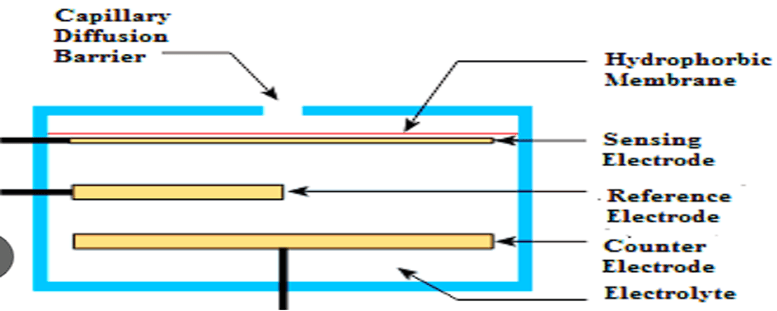
·
Working Principle of Electrochemical sensors
These sensors detect gases through a chemical reaction between the gas and an electrode in the sensor, producing an electrical signal proportional to the gas concentration. The sensor has a sensing electrode (working electrode), a counter electrode, and often a reference electrode immersed in an electrolyte. The gas diffuses through a membrane and reacts at the electrode, causing oxidation or reduction, which generates a measurable current.
- Common Gases Detected:
- Carbon Monoxide (CO)
- Hydrogen Sulfide (H₂S)
- Oxygen (O₂)
- Chlorine (Cl₂)
- Applications:
- Industrial Safety: Detecting toxic gases like CO and H₂S in confined spaces such as mines and chemical plants.
- Environmental Monitoring: Monitoring air quality by detecting pollutants.
- Healthcare: Oxygen sensors in respiratory equipment or anesthesia monitoring systems.
3. Infrared (IR) Gas Sensors
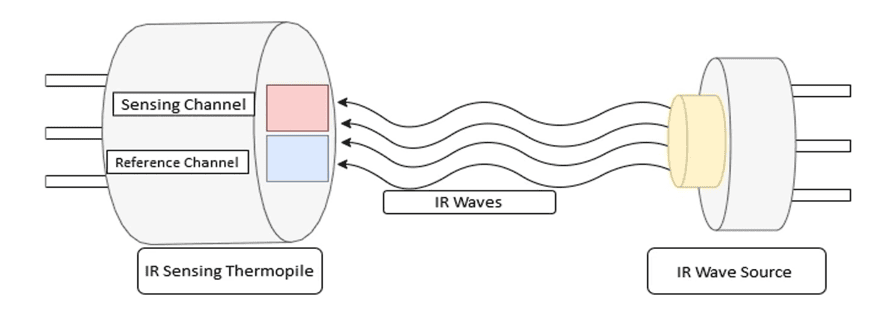
Working Principle of Infrared Gas Sensors
These sensors detect gases by measuring the absorption of specific wavelengths of infrared light by gas molecules. Each gas absorbs light at characteristic wavelengths, and the sensor detects the intensity of light before and after passing through the gas sample. The difference in light intensity is used to determine the gas concentration.
- Common Gases Detected:
- Carbon Dioxide (CO₂)
- Methane (CH₄)
- Hydrocarbons
- Applications:
- Greenhouse Gas Monitoring: CO₂ sensors in agriculture and environmental studies to monitor air quality and climate change.
- Building Automation: HVAC systems to control ventilation based on CO₂ levels.
- Industrial Process Control: Detecting leaks or controlling gas flow in chemical and petroleum industries.
4. Catalytic Bead Sensors (Pellistor)
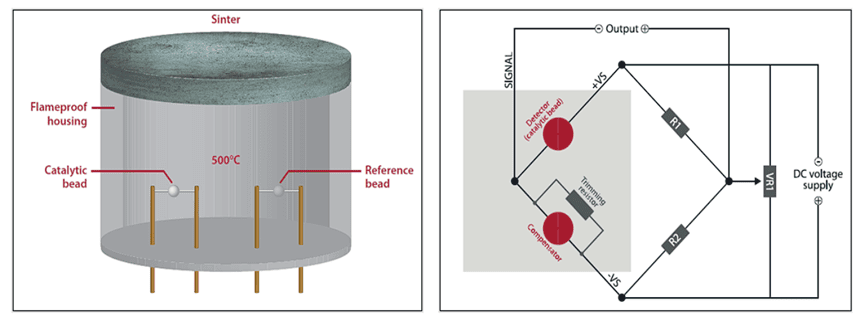
Working Principle Caralytic Bead Sensors
Catalytic bead sensors work by oxidizing combustible gases on the surface of a catalyst. The sensor has two beads – one with a catalyst and one inert bead. The oxidation reaction on the catalytic bead produces heat, causing a temperature increase, which changes the resistance of the bead. The difference in resistance between the two beads is measured and is proportional to the concentration of the combustible gas.
- Common Gases Detected:
- Methane (CH₄)
- Propane (C₃H₈)
- Hydrogen (H₂)
- Other hydrocarbons
- Applications:
- Combustible Gas Detection: In industries dealing with flammable gases, such as oil refineries, chemical plants, and gas storage facilities.
- Mining: Detecting explosive gases like methane in coal mines.
5. Photoionization Detectors
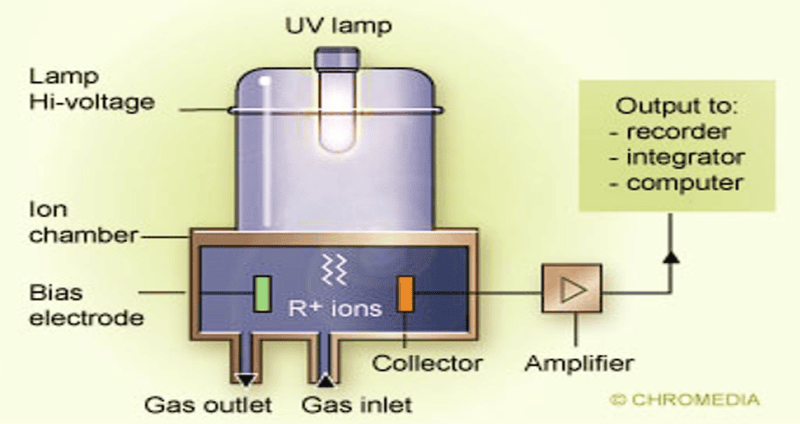
Working Principle of Photoionization Detectors
Photoionization Detectors are use ultraviolet (UV) light to ionize gas molecules. When a gas absorbs UV photons, it gets ionized, creating positive ions and electrons. The resulting current is proportional to the concentration of the ionized gas. PIDs are highly sensitive and can detect gases at very low concentrations (ppm levels).
- Common Gases Detected:
- Volatile Organic Compounds (VOCs)
- Benzene
- Toluene
- Applications:
- Environmental Monitoring: Detecting VOCs in ambient air to ensure compliance with environmental regulations.
- Industrial Hygiene: Monitoring chemical exposure in the workplace, especially in industries dealing with paints, solvents, and fuels.
- Hazardous Materials Response: Used in first-responder equipment to detect hazardous gases during chemical spills or leaks.
7. Thermal Conductivity Sensors
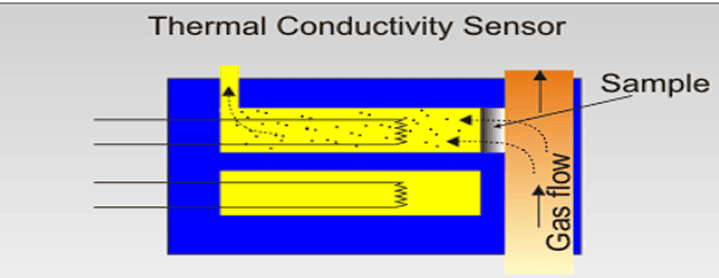
Working Principle of Thermal Conductivity Sensor
Thermal conductivity sensors detect gases based on the principle that different gases have different abilities to conduct heat. The sensor compares the thermal conductivity of the target gas to a reference gas (usually air). A heated element in the sensor responds to changes in the thermal conductivity when the target gas flows over it, altering the temperature and thus resistance of the element.
- Common Gases Detected:
- Hydrogen (H₂)
- Helium (He)
- Methane (CH₄)
- Argon (Ar)
- Applications:
- Industrial Gas Detection: Detecting hydrogen or helium in industrial processes.
- Process Control: Monitoring gases in chemical and petrochemical industries.
- Hydrogen Production: Monitoring hydrogen levels in fuel cells or electrolyzers.
8. Acoustic Wave Sensors
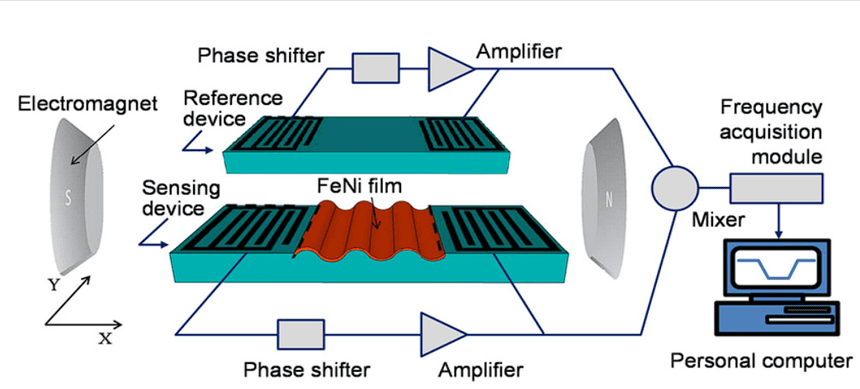
Working Principle of Acoustic Wave Sensor
Acoustic wave sensors operate by detecting changes in the speed or attenuation of sound waves as they pass through or along the surface of a sensing material. When the gas interacts with the surface, it changes the mass or properties of the material, altering the acoustic wave characteristics. This change is used to detect gas concentration.
- Common Gases Detected:
- Various gases depending on the sensing material and application.
- Applications:
- Environmental Sensing: Used in gas leak detection or ambient air monitoring.
- Industrial Monitoring: Detection of specific gases in harsh environments, including chemical and petrochemical plants.
Conclusion
Gas sensors are vital technologies used across various industries for ensuring safety, environmental protection, and efficient operations. By detecting harmful gases and monitoring air quality, they play a crucial role in safeguarding both human life and industrial processes. Each type of gas sensor whether electrochemical, semiconductor, infrared, or catalytic serves specific purposes, tailored to detect particular gases and conditions.
Their widespread applications, from homes to heavy industries, highlight the importance of precise, reliable gas detection in mitigating risks and enhancing operational efficiency. As technology advances, gas sensors continue to evolve, offering even more accuracy and versatility in diverse environments.
